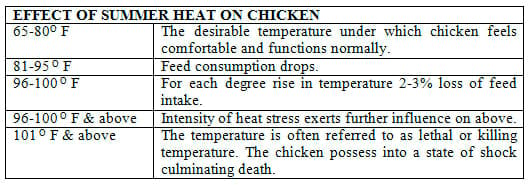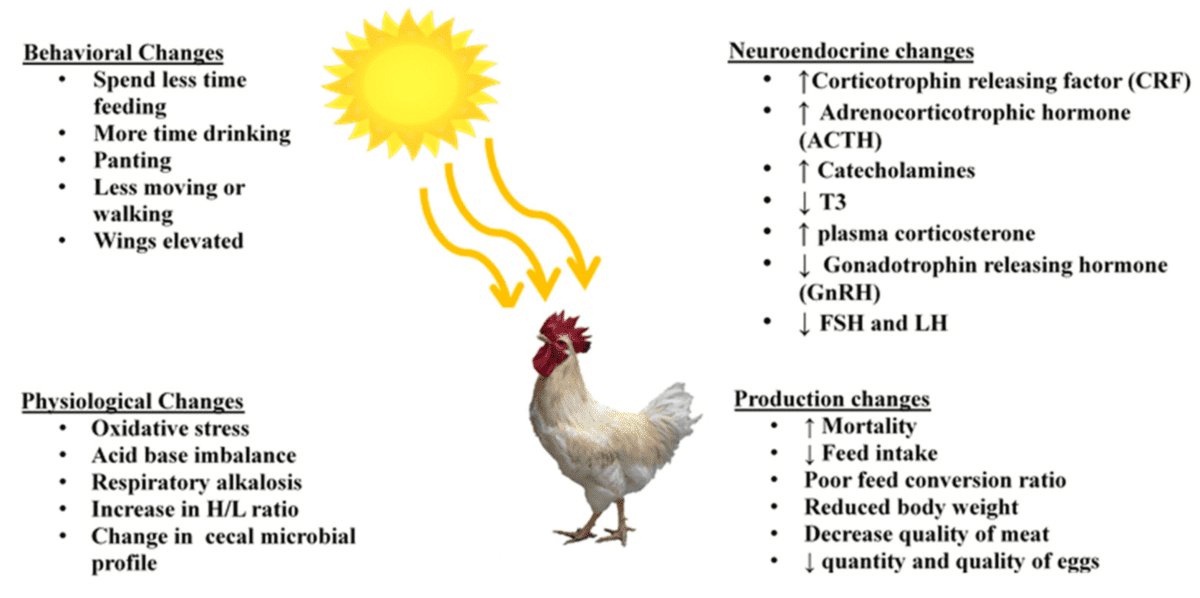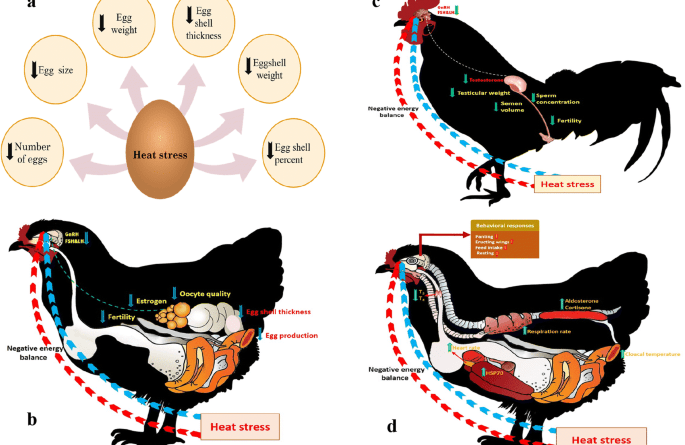Poultry Farming and Adverse Season as a Stressor
There are different environmental stress causes adverse effects on performance of poultry, the environment can be defined as the combination of external conditions which have an impact on animals and humans.
Perhaps the most important physiological response of poultry to the environment is the constant maintenance of a homoeothermic state during exposure to extreme ambient temperatures.
There are different types of stressors, namely:
1. Climatic stress which may be either a Heat stress or Cold stress.
2. Management stress which includes Excess light, Wet litter and Poor ventilation.
3. Nutritional stress which may either include excess salt or low nutrition.
4. Physiological stress which can be caused either from rapid growth or sexual maturity.
5. Physical stress which can occur during catching of birds, injecting the birds, immobilization of the birds and transportation of birds.
6. Social stress which is most times comes as a result of overcrowding of birds and poor body weight of the birds.
7. Psychological stress which occurs during stress or by harsh caretakers.
Among all these types of stressors, environmental stress adversely affects the production performance of commercial poultry. In general the ideal temperature for optimum poultry production is 65-75ºF.
Birds like mammals are homoeothermic which means they can maintain a relatively constant deep body temperature 41.7ºC (107ºF).
Read Also: Bird flu in the Poultry Farm and How to tackle it
The environment in which poultry is maintained is the single most important factor affecting productivity. The thermoregulatory mechanism in birds is effective only upon the ambient temperature within certain limits (18-28ºC). Beyond this, birds cannot adjust well.
The upper lethal temperature in birds is about 47ºC (116.8ºF), this is called thermo-neutral or zone of comfort during which birds do not change their behavior or signs of discomfort and use minimum amount of metabolic energy to maintain homoeothermic range of body temperature.
Within the thermo-neutral zone, body temperature is maintained by the thermal equation (heat production = heat loss).
Effect of Heat on Poultry Chickens

Most important effect of heat stress is decrease in body resistance and more susceptibility to E.coli and CRD etc. In summer outbreaks of gout may be seen in broilers and layers.
In heat stressed birds blood flow increases to upper respiratory tract, skin and abdominal muscles for relieving heat, however, blood flow to intestinal tract is decreased.
As a result there is reduction in appetite leading to lower feed intake. Concurrently water intake is increased resulting in fluid contents in intestinal tract. This further cause’s diarrhea that results in loss of electrolytes needed to maintain acid base balance.
Clinical Signs or Symptoms

The following clinical signs will be observed in heat stressed birds:
- Panting/rapid respiration
- More intake of water
- Reduced appetite.
- Reduction of egg production
- Poor egg shell quality
- Less body weight gain in broilers
- Reduced feed efficiency
- Increase in body temperature
- Death
Post-Mortem Lesions
- Dehydrated carcass
- Mucoid exudates in mouth and nostrils
- Pale/cyanotic combs
- Pale breast muscles
- Congestion of liver, spleen, kidney and lungs.
- Fluid contents in intestines.
- Rapid decomposition of carcass
Steps to Combat Heat Stress in Poultry Farming

The aim of adopting measures to combat heat stress is not only to keep birds alive but also to get production out of them to achieve targeted figures i.e. number of egg from layers and a better body weight at particular age with specific FCR in broilers.
Following steps will help to combat heat stress in birds:
- Poultry Housing Management
- Water Management
- Poultry Feed Management
- General Management
1. Poultry Housing Management
1. Orient the long axis of poultry house in an east-west direction to minimize solar heating and direct access to sunlight.
2. Poultry houses in tropics should have good roof insulation (if possible with false roof to reduce the conduction of heat) with support of foggers and cooler systems.
3. In open sided houses, width of house will be a limiting factor so keep the optimum width (24-32 ft) based on temperature, humidity and wind velocity, type of house and nature of bird for effective cross ventilation.
4. Increased air movement over the birds by cooler fans/exhaust to produce a wind chill effect which will cool birds even without drop in the house temperature.
5. Shed design and construction should not allow direct sunlight on birds.
6. Thatching of roof with paddy straw or sugar cane leaves will reduce temperature inside the shed.
7. The roof should be painted with white wash to reflect light.
8. Shades from tall trees and plantation around the sheds can reduce the radiant heat. The plantation of trees should be such that trees will be leafy during summer and bald during winter.
9. Roof overhangs should be sufficient (3-5 ft) to protect the birds from strong sunrays.
Read Also: Vaccination Program for Poultry Chickens
2. Water Management
Practically water is the most important criteria of these four managemental factors during summer. In summer water consumption is 3-4 times more. Even a slight shortfall of water can lead to heat stroke and mortality.
Normally feed and water consumption ratio is 1:2 but when temperature shoots beyond 95oF, this ratio may increase up to 1:4 or more. Some of the major points to be taken into consideration include the following:
1. Supply of plenty of clean and cool water (60-70oF) must be ensured during summer months.
2. Use good quality sanitizers in water to control infections through water.
3. For day old chicks provide cool water and electrolytes on their arrival to farm before offering feed to avoid dehydration after transportation.
4. Cover water tanks with wet gunny bags to avoid direct exposure to sun.
5. Increase number of waterers by 25%.
6. Increase frequency of watering.
7. In case of nipple drinkers, insulate nipple pipe with wet gunny cloth.
8. Provide electrolyte (1-2 gm/liter) in water during hot hours.
9. Addition of 0.25% of salt to drinking water increases water consumption.
10. Adjust the amounts of medications and volumes of water used for water vaccination to reflect the increase water consumption of the flock during hot weather.
11. Do not withhold drinking water from the flock when vaccine is provided through drinking water.
12. Use good quality sanitizers in water to control infections through water.
13. For day old chicks provide cool water and electrolytes on their arrival to farm before offering feed to avoid dehydration after transportation.
14. Cover water tanks with wet gunny bags to avoid direct exposure to sun heat.
15. Increase frequency of watering.
3. Poultry Feed Management

1. During summer consumption of feed by birds is reduced considerably leading to reduced body weight, egg production and shell quality.
2. Increase the frequency of feeding.
3. Do not offer feed during day time in broilers.
4. Certain changes in feed formulations are necessary.
5. Increase nutrient density of feed to compensate for depressed feed intake.
6. Energy of feed should be reduced. Crude protein content should not be increased because heat generated by one gram of fat is 16.5% or one gram of fat is 22.5%.
7. Similarly 20-30% extra vitamins and trace minerals should be added to feed.
8. Available phosphorus content of feed should be increased.
9. Vitamin C is necessary to maintain integrity of blood vessels. Supplementation of vitamin C @ 200-500 gm /ton feed will be beneficial.
10. Vitamin E @ 50 gm /ton feed will also be beneficial.
11. Pelleted feeding is beneficial where low energy fiber diets are used
12. Add soda-bicarbonate @ 0.1% for improvement of shell quality.
13. Since hot humid climate favors growth of moulds/fungi in feed, so constant use of anti-fungal is recommended.
14. The diet should be balanced with limiting amino-acids, methionine and lysine which will give better results.
15. Increase the calcium level from 3-3.5% in layer diet.
16. Inclusion of vitamin A 8000 IU and vitamin E 250mg /kg diet for better performance and combat heat stress.
Read Also: Importance of Multivitamins in Poultry Production
4. General Management
1. Litter preferably fresh litter of 2 inches thickness with racking or stirring of litter 2-3 times a day during cool hours is recommended.
2. 10% extra floor space should be provided in summer.
3. Overcrowding of birds should be avoided.
4. Shifting, transportation, debeaking and vaccination should be done during night or cool hours of the day.
5. Birds severely heat stressed may be dipped in cold water for 2-3 minutes keeping their neck and head above water level.
6. Provide proper cross ventilation.
7. Fans (pedestal, ceiling or exhaust) may be fitted in sheds.
8. Use foggers in the shed which could reduce the shed temperature up to 5-10oC depending upon quality.
9. Use of paint ,white lime etc. practically reduces the shed temperature up to 2oC.
10. Use side curtain in shed which should be sprinkled with water.
11. Provide 3 exhaust fans on one side and pad cooling on other side (200ft) which completely seals the shed sides and brings down temperature below 8oC.
12. Use sprinklers on the top or inside shed.
13. Surround the house with tall trees.
14. Thatched roof is suitable for hot areas.
15. The house should be situated away from other buildings in order to facilitate free movement of air.
16. High altitude of roof is ordinarily 2.6 to 3.3 m from foundation to the roof line to provide maximum ventilation.
17. Provide 1meter overhang to cut the direct sun and rain into the house.
Read Also: Comprehensive Guide on How to start Cockerel Farming









